A tutorial example of using Facebook Ads for Event Promotion
Promoting live events might be the most challenging form of digital marketing campaign you will ever work on. Or so it’s been my experience over the past few years with our monthly MnSearch events and one-off events like LocalU Twin Cities.
Not only do you have to try to market an event based on features, benefits and price points, but you also have to try and convince someone that it’s worth taking time out of their work day or personal life, and drive across town to attend. And all for 'One Night Only!'.
This is the exact opposite from most Paid Search campaigns that can be built to be relatively 'Evergreen'.
Because attendance can fluctuate greatly, and breaking even is often the priority goal, we are continually looking for very cost effective means of building awareness for events without breaking the bank.
All of this led us to Facebook ads.
Why Facebook Ads for event promotion?
- Cost: Let’s address this first off. Cost is often a primary driver of trying new advertising mediums for unproven verticals or products. Since MnSearch is a non-profit with every little budget for advertising, we have to be careful with what and where we spend our limited resources. The DYI ad platform with a relatively low cost-per-click made it an easy decision for trying Facebook ads for our events. Our initial monthly budget was only $40 per month.
- Audience Size: Facebook is the undisputed heavyweight of social networks. Odds are that most of the people you want to reach will be on Facebook. For us, being a digital marketing association, it was a very easy, and accurate, assumption that other search marketers would be there. We just needed to figure out how to target them…
- Demographic and Interest Targeting: Event marketers will love Facebook for its targeting features since most events are for specific people with specific interests.In the case of MnSearch, our audience lives in close approximation to the Twin Cities, is a working professional 21 years of age or older, and works in a web-based field with interests in search, social and other digital marketing topics.
- Community Building (+ Social): As I mentioned earlier, our goal is to build a search marketing community here in Minnesota. This includes building a community online as well as at our in-person networking events.
The extra benefit that Facebook Ads provided us is to the growth to our social community. Every month that we advertise our events on Facebook, we see a 78% growth in our month-over-month social connections.
This is above the normal growth that we see during months where no advertising has occurred and includes Facebook followers, Twitter followers and LinkedIn community members, not to mention the lift in official MnSearch Association memberships.
All of this with only a small $40 monthly budget. I wonder what would happen if we had budget in the $400 range, or $4,000…? That’s probably a test and post for another day.
Recommended assets for marketing an event through Facebook Ads
Facebook has a fairly flexible ad platform for marketing events. I always recommend creating the following assets for in order to utilize the main Ad options for events and get the most out of them.
-
1. Create an Event page on your website, event registration platform or both.
In the era of inbound marketing, creating your own (owned) content for events is a must. To do so you will only need to create a detailed event page on your website, blog or an event registration engine that you manage and control. Not only will this make it easy for you to update your event listing as needed, but you will be able to gain additional traffic, links and social equity over time to a place that you can carry forward.
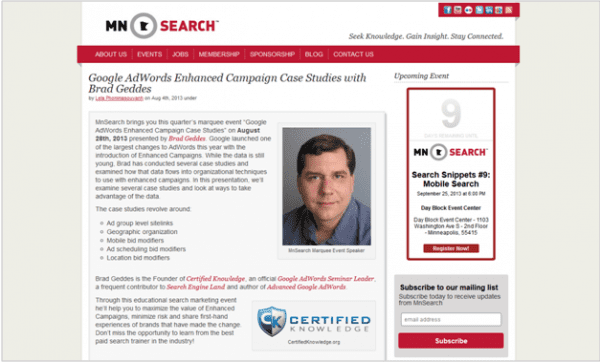
-
2. Create a Facebook Event through your Facebook Page
There is a saying that advertisers have in regards to Facebook users and conversions. It is: 'Facebook users like to stay on Facebook.' This saying is in relation to gaining higher conversion rates from Facebook ads if you can craft an offer or landing page that does not take the user out of Facebook. It is not necessary, but something to keep in mind when planning your campaign.
Also, creating this page is important if you want to use the Facebook ad option for advertising a Facebook event. This is a step that I recommend so that you gain access to the additional ad format.
This event page will include information about your event including date, time, location, event description, and a link to the event ticket registration page on your main website or registration platform.
The optional attendee list is a great form of social proof. Enabling it will help increase conversions by people being able to see that they are not alone and hopefully know a few others that are attending.
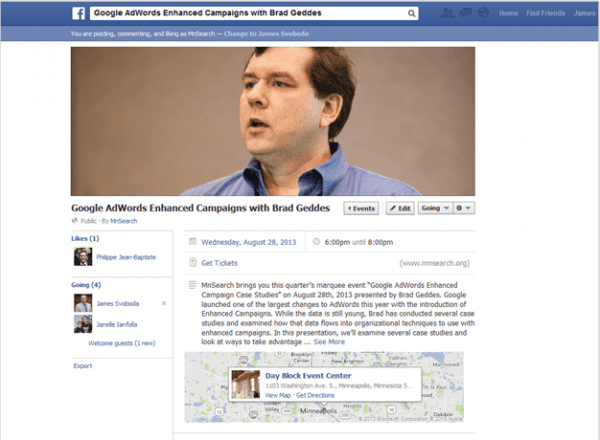
-
Share Your Event Post(s) on Facebook to establish initial social proof
One of the great advantages to promoting events on Facebook it the social proof that you gain when someone joins, likes, or comments on your Event. This helps demystify who you are as an organization for users when they see someone they know that has taken an action on the event.
In preparing for my event ad campaigns I always share event assets prior to advertising so that they gain some social equity. This will help get your ads off and running faster than new ones that do not have any 'likes'.
When sharing your assets, I recommend a staggered schedule so that your audience is not inundated with messages about the same event all at one time. Scheduling them to post 4-8 hours, or 1-3 days apart will help to avoid this.
Staggered schedule for Facebook content for your event
Here is a schedule I like to follow and considerations:
- 1. Event action #1 – AM, Day 1: Main Event Post
I often look to make my 1st event post to Facebook during the morning of what I consider day 1 of promotion. This is the link to the page with full details from the website, blog or event registration platform. I typically like to post this on a Tuesday or Wednesday during the 9 am hour.
Tip: You do not have the opportunity to edit the copy of your Posts when turning them into Sponsored Stories (ads).
Because of this I highly recommend editing this post to the following character limits so that it will show up correctly in streams without getting truncat…
- 90’ish character max as the status copy area above the post box.
- Edit and keep important Title copy of the post in the 1st 30'ish characters (blue box area). It’s Ad will truncate longer sponsored post titles.
- 142'ish character post description (blue box area). Ad will truncate longer copy.
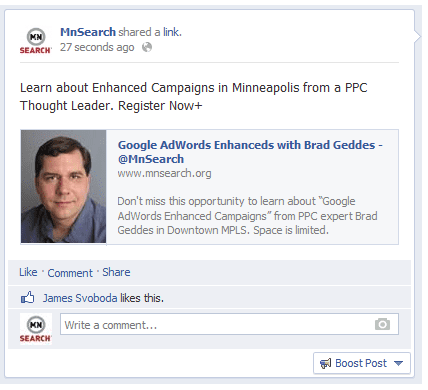
As a side note: remember to proofread your edited copy before posting:)
- 2. Event action #2 – AM, Day 2: Create sponsored story Ad from Main Event Post
Since taking a post and creating a Promoted Page Post (aka Sponsored Story Ad) will not create another entry on your page’s timeline, I recommend doing this on the morning of Day 2, or late in the day of Day 1. The reason for the delay is so that your original post has time to gather social equity that will help engagement and reach when it’s turned into an ad.
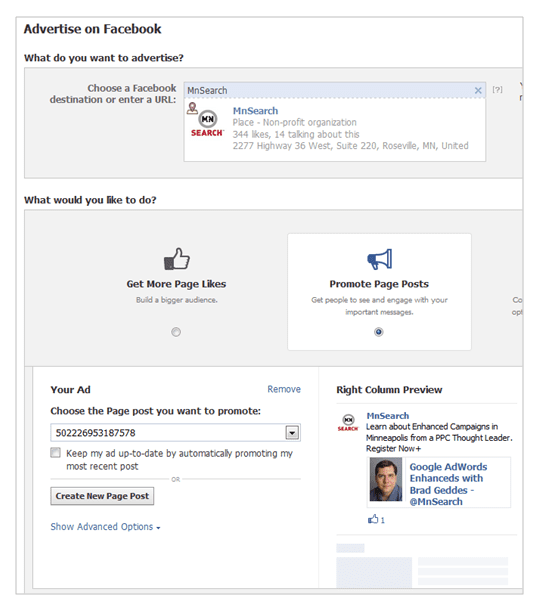
- 3. Event action #3 – AM, Day 2: Create Facebook Event
Just like when creating the Main Event Post (above), I typically line up the Facebook Event creation to be done during the morning of day 2, or later, so that we are not posting our Event messages too close together.
Character Limit Note: You’ll need to create new copy for Promoted Event Ads. Because of this you will not need to adhere to any character limits when creating your initial Facebook Event posting.
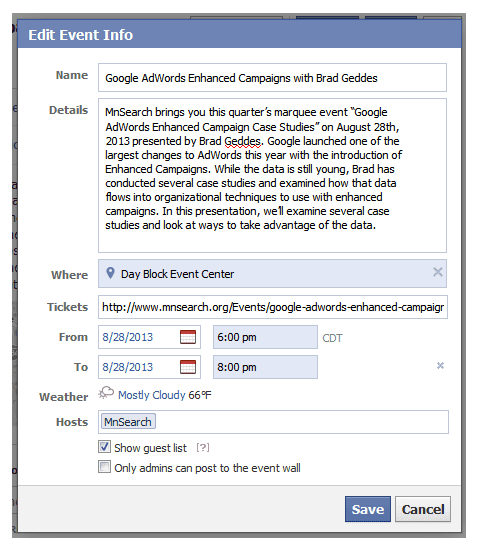
- 4. Event action #4 – PM, Day 2: Share Facebook Event
As you can see from the example below, creating the Facebook Event automatically posts it to your follower’s stream, so you’ll want to balance this with sharing the event at a later time so that your postings are pushed out one on top of the other. This spreads out the exposure and gives you more time to gain social equity before promoting via Facebook ads.
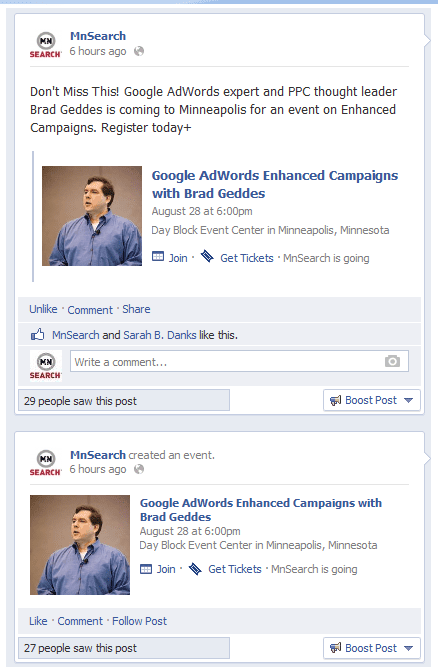
- 5. Event Action #5 – AM, Day 3: Create Ad for your Facebook Event
Now that your Facebook Event has had time to curate some social activity it’s time to turn it into an Ad. You’ll find this ad option by going to your 'Create Ad' section for you Page and your event should be listed towards the bottom of the options.
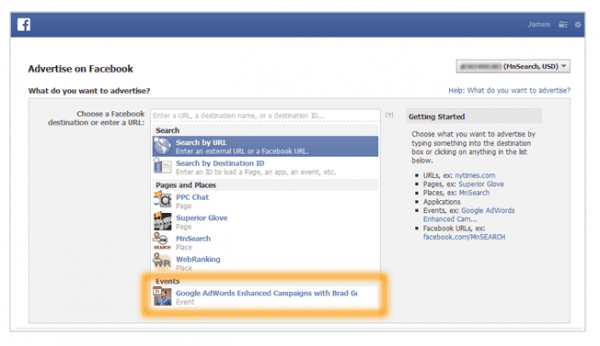
You should not that you Event Ads will need to adhere to the following structure:
- 25 character max headline.
- 90 character max text description.
- 100 px wide x 72 px tall event image.
Targeting the Right Audience (Ad Settings)
Most of the audience targeting and ad settings can be used for almost all of the different ad formats that Facebook offers. Here are the popular settings that I use and some that you should consider for your campaigns.
- Location: Most events that happen 'in real life' will have an audience that resides within a geographic area. This could be North America, the United States, in a specific state like Minnesota or Oregon, or within driving distance from the event location. We often choose a radius targeting of 25 or 50 miles from where we are holding our monthly events here in the Twin Cities. We’ll increase this reach to statewide for larger events.
- Age: Are you promoting an event that is intended for an adult audience? Is your event going to provide alcohol and needs to target the 21 and over crowd? Our audience is made up of mostly working professionals and being able to target people that are 21+ is a great feature for marketing our events.
- Gender: Are you looking to market an event that primarily attracts women or men? If so, then you can select the gender of users to target and greatly reduce your audience size and thus ad spend. If you don’t know, I’d recommend splitting your campaign into 2 and testing the male vs. female audience and see which one performs better for you.
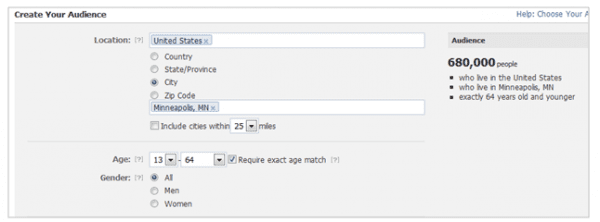
- Precise Interests: Targeting users by their Interests is one of the best features of Facebook ads. For instance, if your event is a children’s broadway show, then your targeted audience might have an interest in Sesame Street.For MnSearch, we are looking to reach working professionals whom have shown an interest in digital marketing topics such as PPC and Google AdWords.
- Suggested Likes and Interests: Facebook tries to help you find additional Interests that you may not have found yet by making suggestions based on the Precise Interests that you have previously selected. This is by no means perfect, but can help uncover some real gems that you might not have thought of previously.
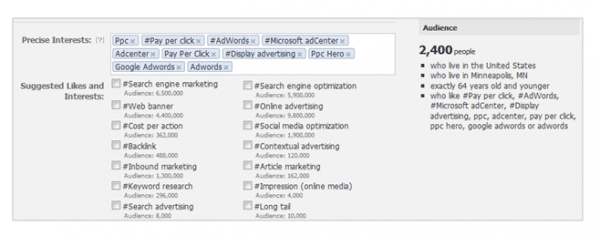
- Broad Categories: Adding Broad Categories can help narrow your ad reach to better audience. Using the children’s broadway show example from above, narrowing the scope of your reach to Parents would be a good idea to consider.

- Connections: I typically recommend using the Advanced Connection Targeting option to fine-tune who sees your ads. When trying to target a new audience that has not yet been exposed to any or our current event messaging or our MnSearch brand, I will restrict the ads from being shown to people already connected to us so as to reduce the possibility of annoying our audience with repetitive messaging.
- Friends of Connections: People often connect based on likes and interested. Targeting users who are friends of people whom like you page is a nice option for building awareness for people whom are likely to be interested. So if you are advertising for that children’s broadway show, you might want to target Friends of Connections and see how that performs

- Interested In and Relationship Status: Targeting users based on sexual preference and relationship status might be the most unused targeting features on Facebook. However, if the event you are trying to market is a relationship seminar, geared towards parents, or single people, these setting can be powerful for reaching your audience.

- Languages: Targeting users based on their language preferences is pretty straight forward. I typically choose all of the English options available. In internet age with laptops and smartphones that can travel, and personal settings that can be changed and forgotten o be changed back, it is usually best to choose more. As for choosing non-English languages such as Spanish or French, this is always an option, however you need to be careful as the person whom clicks you ad might not be able to read your event page if it’s not in their native language.
- Education: User education can sometimes be irrelevant, but should never be ignored for consideration. If your event is a Justin Beiber concert, then you might select the In High School option. If it’s a career fair, then the In College crowd would probably work very well. And if you’re marketing high-end timeshares in a warm climate, then you might want to consider testing the College Grad option.
- Workplaces: I’ve experienced that more often than not, big companies can be found in the workplaces option, while smaller well known ones will not. However, if your event is say, a tech event about the latest mobile devices, then targeting Best Buy employees might suit you. Or if it’s a convention about hospitality, then Best Western would be an option for you. It’s never a bad idea to see if a company is listed that could be a good fit for your campaign.
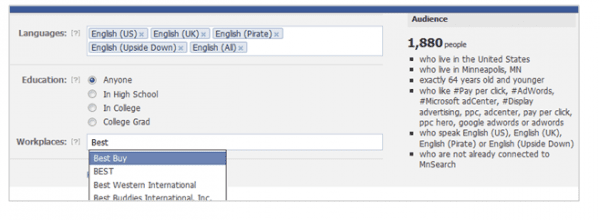
A Few Thoughts about Images
The ability to have images that draw attention is one of the biggest advantages of Facebook ads. Selecting the right image to go with you ads can be the difference between successfully reaching your audience and completely being ignored.
- People draw attention:It’s a widely known rule-of-thumb that images of people in banner ads and on landing pages draw more attention and can increase conversion rates over other graphics without people. Of course there are always exceptions to any rule.
My advice is to make it common practice to test you Ad Images with people vs. ones without people to see which makes a better impact on your campaigns.
- Bright colours draw attention on Facebook: Let’s face it. Facebook.com is kind of boring. Blue. Grey. Light blue. Dark blue. Other than the little red dot at the top of the page, that’s pretty much the colour palette. For marketers this is a great opportunity to inject color into your Image Ads to make them stand out. I recommend using bold colors such as Red, Orange, Yellow and bright Green.
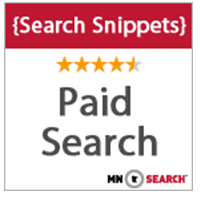
At MnSearch we create special badges for each of our monthly Search Snippets events that we place on our event pages. These images show up with our social posts on Facebook, LinkedIn and Google+ and get extra use in our Facebook Event campaigns.
Consider the colour of the image when you are selecting if for you event ad images. If you have more than one image to run, test them against each other to see which performs better with your audience.
- Sponsored Post Ad Images vs. Event Ad Images: I highly recommend using different images for you Event Ads than you use for your Promoted Posts. This will help to reduce ad fatigue, give you additional ways to grab attention akin to split-testing, and give your ads a fresh perspective and second look when the same user views them.
Create and manage demographic audiences in Facebook Power Editor
Because finding, managing and tracking audiences can be tricky for time sensitive Events, I recommend establishing your Audiences within the Facebook Power Editor.
These Audiences will allow you to easily add Interests and fine-tune your demographic targeting for use with future event promotions without having to create new ones each time.

How are your event promotions going?
As I mentioned earlier, Facebook is a fairly flexible ad platform for marketing events and this post contains just a few of the main ways that you can promote your events. So feel free to let me know if you have any must-haves that I did not include here and I’ll be sure to give you a shout out in my next event post.
Download Expert member resource – Event Marketing Guide
Whatever your business goals, live events can help you achieve them. This guide will give you the strategic advice you need to run successful events.
Access the Event marketing guide

Thanks to James Svoboda for sharing his thoughts and opinions in this blog post. James is a Partner
WebRanking.com, a search marketing agency with offices in Eden Prairie, MN and Portland, OR. He is also President and Co-Founder of the
Minnesota Search Engine Marketing Association, an advisory board member for Which Test Won, Curator for Marketing Land, and frequent host of
#PPCchat. James is also a Husband and Father living in Minnesota. You can find him on
Twitter,
Google+ and
LinkedIn. Original posting on
FBppc.


















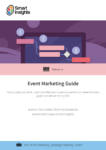
 Thanks to James Svoboda for sharing his thoughts and opinions in this blog post. James is a Partner
Thanks to James Svoboda for sharing his thoughts and opinions in this blog post. James is a Partner 


